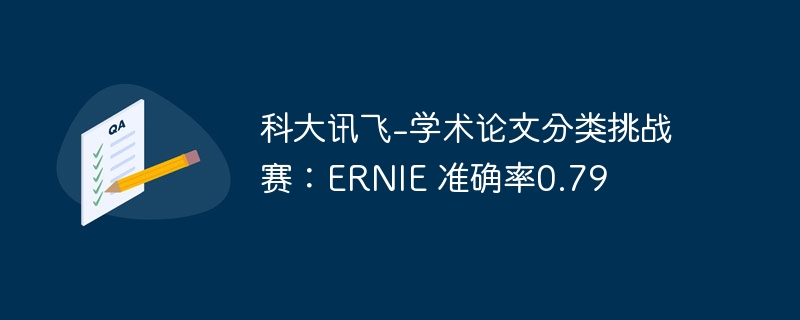随着人工智能技术不断发展,每周都有非常多的论文公开发布。现如今对论文进行分类逐渐成为非常现实的问题,这也是研究人员和研究机构每天都面临的问题。现在希望选手能构建一个论文分类模型。
☞☞☞AI 智能聊天, 问答助手, AI 智能搜索, 免费无限量使用 DeepSeek R1 模型☜☜☜

本次赛题希望参赛选手利用论文信息:论文id、标题、摘要,划分论文具体类别。
赛题样例(使用\t分隔):
paperid:9821title:Calculation of prompt diphoton production cross sections at Tevatron and LHC energies abstract:A fully differential calculation in perturbative quantum chromodynamics is presented for the production of massive photon pairs at hadron colliders. All next-to-leading order perturbative contributions from quark-antiquark, gluon-(anti)quark, and gluon-gluon subprocesses are included, as well as all-orders resummation of initial-state gluon radiation valid at next-to-next-to-leading logarithmic accuracy. categories:hep-ph
训练数据和测试集以csv文件给出,其中:
训练集5W篇论文。其中每篇论文都包含论文id、标题、摘要和类别四个字段。
测试集1W篇论文。其中每篇论文都包含论文id、标题、摘要,不包含论文类别字段。
本次竞赛的评价标准采用准确率指标,最高分为1。
计算方法参考https://scikit-learn.org/stable/modules/generated/sklearn.metrics.accuracy_score.html, 评估代码参考:
from sklearn.metrics import accuracy_scorey_pred = [0, 2, 1, 3]y_true = [0, 1, 2, 3]
!pip install paddle-ernie > log.log
import numpy as npimport paddle as P# 导入ernie模型from ernie.tokenizing_ernie import ErnieTokenizerfrom ernie.modeling_ernie import ErnieModel
model = ErnieModel.from_pretrained('ernie-1.0') # Try to get pretrained model from server, make sure you have network connectionmodel.eval()
tokenizer = ErnieTokenizer.from_pretrained('ernie-1.0')
ids, _ = tokenizer.encode('hello world')
ids = P.to_tensor(np.expand_dims(ids, 0)) # insert extra `batch` dimensionpooled, encoded = model(ids) # eager executionprint(pooled.numpy())import sysimport numpy as npimport pandas as pdfrom sklearn.metrics import f1_scoreimport paddle as Pfrom ernie.tokenizing_ernie import ErnieTokenizerfrom ernie.modeling_ernie import ErnieModelForSequenceClassification
train_df = pd.read_csv('train.csv', sep='\t')
train_df['title'] = train_df['title'] + ' ' + train_df['abstract']
train_df = train_df.sample(frac=1.0)
train_df.head()train_df.shape
train_df['categories'].nunique()
train_df['categories'], lbl_list = pd.factorize(train_df['categories'])
# 模型超参数BATCH=32MAX_SEQLEN=300LR=5e-5EPOCH=10# 定义ernie分类模型ernie = ErnieModelForSequenceClassification.from_pretrained('ernie-2.0-en', num_labels=39)
optimizer = P.optimizer.Adam(LR,parameters=ernie.parameters())
tokenizer = ErnieTokenizer.from_pretrained('ernie-2.0-en')train_df.iterrows()
# 对数据集进行转换,主要操作为文本编码def make_data(df):
data = [] for i, row in enumerate(df.iterrows()):
text, label = row[1].title, row[1].categories
text_id, _ = tokenizer.encode(text) # ErnieTokenizer 会自动添加ERNIE所需要的特殊token,如[CLS], [SEP]
text_id = text_id[:MAX_SEQLEN]
text_id = np.pad(text_id, [0, MAX_SEQLEN-len(text_id)], mode='constant')
data.append((text_id, label)) return data
train_data = make_data(train_df.iloc[:-5000])
val_data = make_data(train_df.iloc[-5000:])# 获取batch数据def get_batch_data(data, i):
d = data[i*BATCH: (i + 1) * BATCH]
feature, label = zip(*d)
feature = np.stack(feature) # 将BATCH行样本整合在一个numpy.array中
label = np.stack(list(label))
feature = P.to_tensor(feature) # 使用to_variable将numpy.array转换为paddle tensor
label = P.to_tensor(label) return feature, labelEPOCH=1# 模型训练for i in range(EPOCH):
np.random.shuffle(train_data) # 每个epoch都shuffle数据以获得最佳训练效果;
ernie.train() for j in range(len(train_data) // BATCH):
feature, label = get_batch_data(train_data, j)
loss, _ = ernie(feature, labels=label)
loss.backward()
optimizer.minimize(loss)
ernie.clear_gradients() if j % 50 == 0: print('Train %d: loss %.5f' % (j, loss.numpy()))
# 模型验证
if j % 100 == 0:
all_pred, all_label = [], [] with P.no_grad():
ernie.eval() for j in range(len(val_data) // BATCH):
feature, label = get_batch_data(val_data, j)
loss, logits = ernie(feature, labels=label)
all_pred.extend(logits.argmax(-1).numpy())
all_label.extend(label.numpy())
ernie.train()
acc = (np.array(all_label) == np.array(all_pred)).astype(np.float32).mean() print('Val acc %.5f' % acc)test_df = pd.read_csv('test.csv', sep='\t')
test_df['title'] = test_df['title'] + ' ' + test_df['abstract']
test_df['categories'] = 0test_data = make_data(test_df.iloc[:])all_pred, all_label = [], []# 模型预测with P.no_grad():
ernie.eval() for j in range(len(test_data) // BATCH+1):
feature, label = get_batch_data(test_data, j)
loss, logits = ernie(feature, labels=label)
all_pred.extend(logits.argmax(-1).numpy())
all_label.extend(label.numpy())pd.DataFrame({ 'paperid': test_df['paperid'], 'categories': lbl_list[all_pred]
}).to_csv('submit.csv', index=None)以上就是科大讯飞-学术论文分类挑战赛:ERNIE 准确率0.79的详细内容,更多请关注php中文网其它相关文章!

每个人都需要一台速度更快、更稳定的 PC。随着时间的推移,垃圾文件、旧注册表数据和不必要的后台进程会占用资源并降低性能。幸运的是,许多工具可以让 Windows 保持平稳运行。

Copyright 2014-2025 https://www.php.cn/ All Rights Reserved | php.cn | 湘ICP备2023035733号